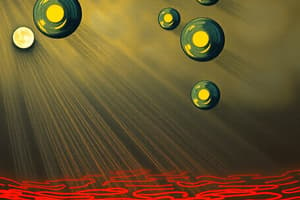Podcast
Questions and Answers
Which component of a heat exchanger is responsible for separating different fluid pathways, specifically in the shell side?
Which component of a heat exchanger is responsible for separating different fluid pathways, specifically in the shell side?
- Tubesheet
- Channel head cover
- Floating head
- Pass partition (correct)
What is the primary feature of a double pipe heat exchanger?
What is the primary feature of a double pipe heat exchanger?
- It has several pipes or tubes within a larger vessel.
- It consists of flat plates stacked together.
- It utilizes a tube within another tube for fluid flow. (correct)
- It has tubes with extended fins for heat transfer.
Which type of heat involves a temperature change?
Which type of heat involves a temperature change?
- Specific heat
- Latent heat
- Conductive heat
- Sensible heat (correct)
In which type of heat exchanger do fluids pass through alternate channels between plates?
In which type of heat exchanger do fluids pass through alternate channels between plates?
Which flow pattern is characterized by a smooth flow with lower velocities?
Which flow pattern is characterized by a smooth flow with lower velocities?
Which of the following is not a potential problem with heat exchangers?
Which of the following is not a potential problem with heat exchangers?
What is the function of a tube sheet in a heat exchanger?
What is the function of a tube sheet in a heat exchanger?
What is a primary characteristic of a spiral heat exchanger?
What is a primary characteristic of a spiral heat exchanger?
Which flow pattern is known to be more efficient for heat transfer?
Which flow pattern is known to be more efficient for heat transfer?
Which type of heat exchanger is ideal for cryogenic applications?
Which type of heat exchanger is ideal for cryogenic applications?
What is the primary function of the floating head in a shell and tube heat exchanger?
What is the primary function of the floating head in a shell and tube heat exchanger?
Heat always travels in which direction?
Heat always travels in which direction?
When starting up a heat exchanger, which side is flow typically established first?
When starting up a heat exchanger, which side is flow typically established first?
Which component of the heat exchanger usually deals with fluid inlets and outlets?
Which component of the heat exchanger usually deals with fluid inlets and outlets?
What defines countercurrent flow in a heat exchanger?
What defines countercurrent flow in a heat exchanger?
Which component in a heat exchanger maintains the liquid at a constant level?
Which component in a heat exchanger maintains the liquid at a constant level?
Flashcards are hidden until you start studying
Study Notes
Heat Transfer Types
- Sensible heat involves a temperature change in a substance without a phase change.
- Latent heat involves a phase change, such as melting or vaporization, where temperature remains constant.
Heat Exchanger Issues
- Potential problems with heat exchangers include fouling, erosion, corrosion, and plugging of U tubes.
- Low heat transfer in a thermosiphon reboiler is also a concern.
Components of Heat Exchangers
- Expansion Joint: Allows tube bundle expansion without touching the shell.
- Weir: Maintains liquid at a constant level in the exchanger shell.
- Tie-rods: Small metal rods fastening baffles and tubesheets together.
- Tube Sheet: Supports and holds the ends of tubes with drilled holes.
Flow Patterns
- Turbulent flow is more efficient for heat transfer compared to laminar.
- Laminar flow is associated with slower velocities in thermal systems.
Heat Transfer Direction
- Heat always travels from a hot body to a cold body.
Startup Procedure for Heat Exchangers
- Typically, flow on the hot side is established first during startup.
Flow Orientations
- Countercurrent Flow: Two streams flow in opposite directions, maximizing heat exchange effectiveness.
- Parallel Flow: Two streams flow in the same direction, resulting in less effective heat transfer.
- Cross Flow: Two streams flow at 90 degrees to each other.
Parts of Heat Exchangers
- Common components include shell side inlet/outlet, tube, tubesheet, channel head cover, and floating head.
- Functionality is determined by correct identification of these components.
Heat Exchanger Types
- Plate & Frame: Flat plates stacked to allow two fluids to pass through alternating channels, exchanging heat.
- Shell & Tube: Several tubes within a vessel; one fluid inside the tubes and another outside.
- Double Pipe: A tube within another tube for fluid exchange via walls.
- Spiral: Rolled square channels, compact for heat exchange.
- Cold Box: Specific for cryogenic applications; typically aluminum, with multiple entry/exit points.
- Air Cooled: Tubes with extended fins for increased surface area to enhance air-based cooling.
Exchanger Applications
- Exchangers can cool vapors to liquids or heat bottoms in distillation columns, aiding in the vaporization process.
- Applications vary based on the need for heating or cooling processes within thermal systems.
Studying That Suits You
Use AI to generate personalized quizzes and flashcards to suit your learning preferences.




